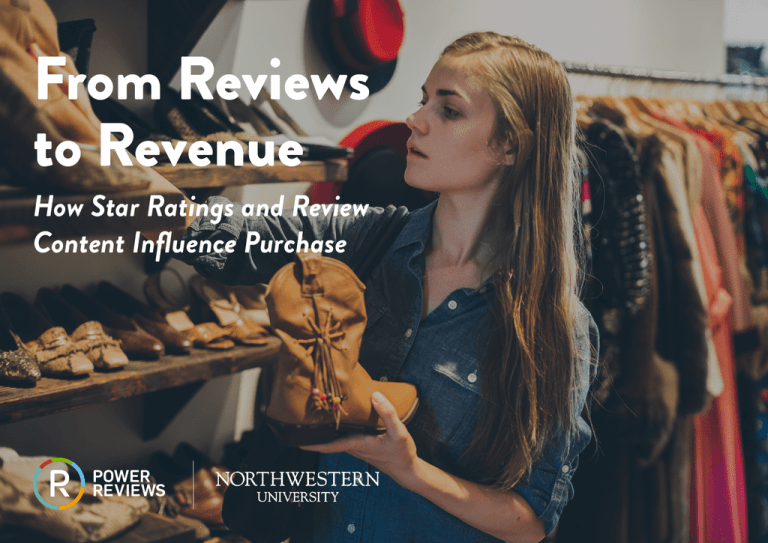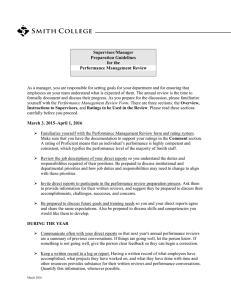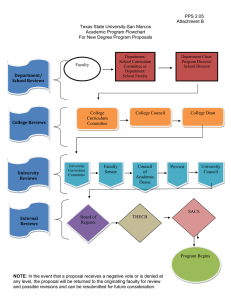Full Paper Summary - The Medill IMC Spiegel Research Center
advertisement

From Reviews to Revenue How Star Ratings and Review Content Influence Purchase ©PowerReviews. All Rights Reserved 2015 From 2015Ratings Retail Revolution to Revenue| |11 Contents 3 Introduction 18 The Effect of the Number of Reviews 4 Perfect is Too Good to Be True 20 4 Recommendations for Brands and Retailers 11 The Importance of Star Ratings for More Expensive Items 21 About the Study and PowerReviews 13 The Influence of Star Ratings in High Consideration Categories 21 About Spiegel Digital and Database Research Center ©PowerReviews. All Rights Reserved 2015 From 2015Ratings Retail Revolution to Revenue| |22 Introduction It’s largely understood that ratings and reviews play a big role in consumers’ purchase decisions. In fact, previous PowerReviews research found that the presence of ratings and reviews is one of the top factors impacting purchase decisions—second only to price . But what’s less obvious are the circumstances under which reviews have the biggest impact on purchase. probability of sales. For three months, the Northwestern research team examined: • The relationship of average star rating and purchase probability • The effect of average star rating on products at different price points within the same category PowerReviews recently partnered with Northwestern • The interaction of length and number of reviews on sales University’s Spiegel Digital and Database Research Center to better understand the influence of ratings and reviews This report helps brands and retailers answer the question, as a whole and the role various review elements play on the “How do reviews influence purchase?” as well as understand how to best prioritize their efforts. 1 1 PowerReviews (2014): The Proven Power of Reviews. ©PowerReviews. All Rights Reserved 2015 From 2015Ratings Retail Revolution to Revenue| |33 Perfect is Too Good to Be True ©PowerReviews. All Rights Reserved 2015 From 2015Ratings Retail Revolution to Revenue| |44 A 5 Star Rating Isn’t the Best It may seem obvious that the higher a product’s average star rating, the more likely a person is to purchase it. But the Northwestern research team found that the relationship between the average star rating of a product and its sales is not linear. Simply stated, the likelihood of a product being purchased doesn’t necessarily increase as its star rating increases. Purchase likelihood then peaks when the average star rating of a product is between 4.2 and 4.5 stars and starts to drop as the star rating approaches a perfect 5. A shopper is more likely to purchase a product with an average star rating between 4.2 and 4.5 than one with a 5 star rating. As the graphs that follow show, there is some variation within categories, but the conclusion is the same: a perfect 5 star In general, the number of stars has little effect on purchase rating is not the most desirable. when the rating is between 1 and about 3 stars. But when the star rating surpasses 3, so does likelihood of purchase. In other words, a customer is more likely to purchase a product with a 4 star rating than one with 3 stars. ©PowerReviews. All Rights Reserved 2015 From 2015Ratings Retail Revolution to Revenue| |55 Lightbulbs Most likely to purchase 4.5 Least likely to purchase 1 2 3 4 5 Average Star ©PowerReviews. All Rights Reserved 2015 From 2015Ratings Retail Revolution to Revenue| |66 Hair Color Most likely to purchase 4.2 Least likely to purchase 1 2 3 4 5 Average Star ©PowerReviews. All Rights Reserved 2015 From 2015Ratings Retail Revolution to Revenue| |77 Salon Haircare 4.4 Most likely to purchase Least likely to purchase 1 2 3 4 5 Average Star ©PowerReviews. All Rights Reserved 2015 From 2015Ratings Retail Revolution to Revenue| |88 Negative Reviews Establish Trust Why do purchases drop off once the average star rating surpasses 4.2-4.5? The Northwestern research team believes this is because consumers perceive ratings closer to a perfect 5.0 as “too good to be true.” As counterintuitive as it may that a product can’t be all things to all people, and they appreciate negative reviews as an important element in their decision-making process. In fact, previous PowerReviews research found that 82% of shoppers specifically seek out seem, negative reviews have a positive impact because they negative reviews.1 help establish trust and authenticity. Consumers understand 1 PowerReviews (2014): The Proven Power of Reviews. ©PowerReviews. All Rights Reserved 2015 From 2015Ratings Retail Revolution to Revenue| |99 4.2-4.5 is the ideal average star rating for purchase probability ©PowerReviews. All Rights Reserved 2015 From 2015Ratings Retail Revolution to Revenue| |10 10 The Importance of Star Ratings for More Expensive Items ©PowerReviews. All Rights Reserved 2015 From 2015Ratings Retail Revolution to Revenue| |1111 Reviews Matter for High Priced Items Previous PowerReviews research found that reviews are most important for big-ticket items like appliances, electronics and computers.1 In this study, the Northwestern research team took a different angle, studying the effects of star ratings on low and high priced products within the same category—even a relatively low priced category like hair care products. Northwestern segmented products within each category into low-priced and high-priced items and found that star ratings had a stronger influence on expensive items compared to the cheaper items within the same category. For example, a cheaper hair conditioner with a low average star rating is more likely to be purchased than an expensive hair conditioner with the same low rating. 1 PowerReviews (2014): The Proven Power of Reviews. ©PowerReviews. All Rights Reserved 2015 From 2015Ratings Retail Revolution to Revenue| |12 12 The Influence of Star Ratings in High Consideration Categories ©PowerReviews. All Rights Reserved 2015 From 2015Ratings Retail Revolution to Revenue| |13 13 Where Reviews Matter Most High consideration items: • Expense • Safety • Unknown product • Unknown brand ©PowerReviews. All Rights Reserved 2015 From 2015Ratings Retail Revolution to Revenue| |14 14 Reviews Matter for High Consideration Categories The team also studied the level of involvement or consideration from a consumer’s perspective when purchasing products in a category. For the purposes of this study, high consideration products are defined as products that consumers think more about buying because of: • Higher price • Safety • New brand or product The study found that star ratings are most impactful for expensive products within high consideration categories. Reviews Mitigate Risk What all these factors have in common is risk; purchasing the product requires careful consideration of economic investment, family safety, or personal identity. A consumer may not ordinarily seek out reviews for cereal or shampoo, but if it is a new brand or is higher priced within its category (think organic), more information — in the form of reviews — can strengthen consumers’ confidence in a product, leading to a greater willingness to pay for it. Reviews, then, can be especially important when launching new products or new brands. ©PowerReviews. All Rights Reserved 2015 From 2015Ratings Retail Revolution to Revenue| |15 15 Baby Food Most likely to purchase Least likely to purchase 1 2 3 4 5 Average Star ©PowerReviews. All Rights Reserved 2015 From 2015Ratings Retail Revolution to Revenue| |16 16 Weight Loss Most likely to purchase Least likely to purchase 1 2 3 4 5 Average Star ©PowerReviews. All Rights Reserved 2015 From 2015Ratings Retail Revolution to Revenue| |17 17 The Effect of the Number of Reviews ©PowerReviews. All Rights Reserved 2015 From 2015Ratings Retail Revolution to Revenue| |18 18 The Ideal Number of Reviews Varies Most shoppers need a little nudge to write a review. But how many reviews does it take to impact purchase likelihood? The short answer? It depends. The Northwestern research team found that the ideal number of reviews depends on the length of the reviews themselves. When reviews are shorter, more reviews matter. When reviews are longer, however, the number of reviews has a less significant impact. Short Reviews More reviews drive sales ©PowerReviews. All Rights Reserved Long Reviews More reviews are less impactful on sales 2015 From 2015Ratings Retail Revolution to Revenue| |19 19 4 Recommendations for Brands and Retailers The findings of this study point to some practical recommendations for brands and retailers looking to generate results from ratings and reviews and prioritize their efforts appropriately. 1 2 3 4 Embrace Negative Reviews: Prioritize Higher Priced Items: Consider Sampling for Generate More Reviews: New Brands or Products: The number of reviews for a Your knee jerk reaction may be to reject negative reviews. But the research from Northwestern proves that this isn’t the best course of action to drive sales. While you certainly don’t want to aim for negative reviews, allowing them on your site brings authenticity to your review content and helps you build trust with shoppers, especially because the vast majority of consumers are actively seeking out negative reviews. There’s a higher risk involved with purchasing a higher priced item. Reviews can help consumers overcome this risk, so make these expensive items a higher priority. As the study found, reviews matter when the likelihood of a consumer purchasing a product is inherently low. This is especially true when a brand or product is relatively unknown, or when the product is completely new in an existing category. When a new product or brand is launched into an existing category, it makes sense, then, to actively seek out reviews from consumers. Product sampling can allow brands to generate reviews for new products, which can mitigate risk for future buyers and lead to more sales. ©PowerReviews. All Rights Reserved product can have an impact on sales, especially if those reviews are short. Take a look at your reviews data, and identify products where reviews are generally short. Studies show that up to 80% of reviews originate from post purchase emails, so be sure to send an email to shoppers asking them to review their purchases2. Make the process as simple as possible to generate the most reviews. 2 PowerReviews Internal Data 2015 From 2015Ratings Retail Revolution to Revenue| |20 20 About this Report This report is based on 2015 research conducted by Northwestern University Spiegel Digital and Database Research Center and commissioned by PowerReviews. The Northwestern research team analyzed ratings and reviews data in the consumer packaged goods industry for this study. The data analyzed comes from multiple ecommerce websites, including 22 product categories with a total of 111,460 SKUs. About PowerReviews PowerReviews is the choice of more than 1,000 global brands and retailers to collect and display customer ratings and reviews on more than 5,000 websites. An essential resource for consumers as they search and shop online and in-store, ratings and reviews drive relevant traffic, increase sales, and create actionable insights to improve products and services. About Spiegel Digital and Database Research Center The focus of the Spiegel Research Center is to do evidence-based, data driven analysis to prove the relationship between customer engagement and purchase behavior. The Center’s research focuses on consumer behavior in social media and on mobile devices. www.powerreviews.com info@powerreviews.com @PowerofReviews +1 312-447-6100 | +1 844-231-7540 | +44 (0)20-7152-4452 Chicago | San Francisco | London ©PowerReviews. All Rights Reserved 2015 From 2015Ratings Retail Revolution to Revenue| |21 21

